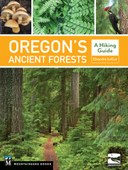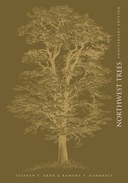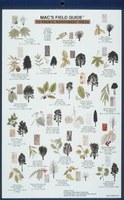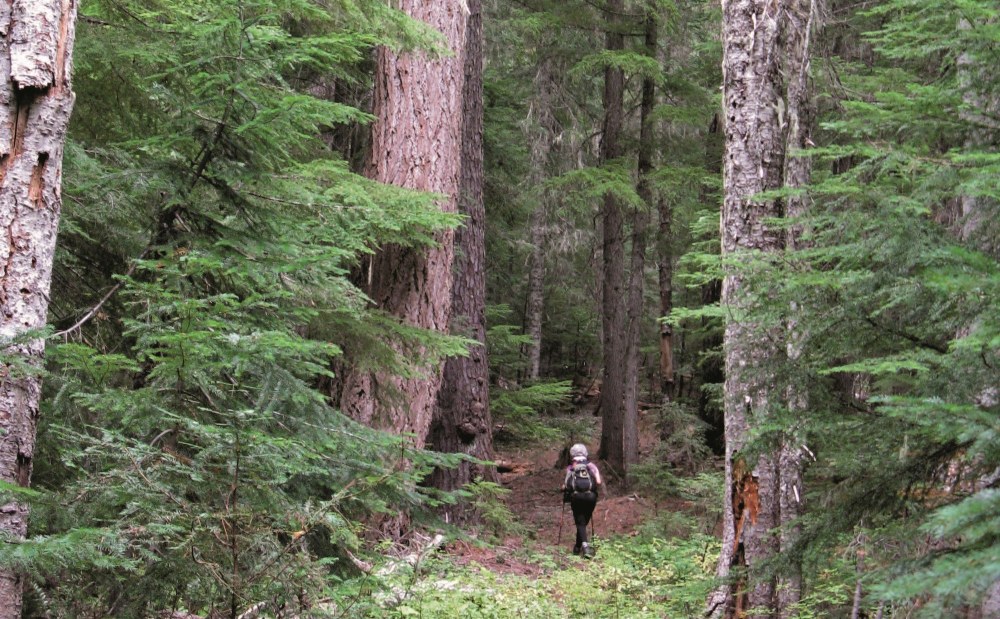
Oregon’s ancient forests are one of the region’s most precious treasures, providing not only vital habitat for fish and wildlife but also some of the most amazing hiking experiences in the state. In Oregon’s Ancient Forests: A Hiking Guide, author Chandra LeGue of Oregon Wild highlights these incredible places with 91 awe-inspiring hikes from across the state.
The following is excerpted from Oregon's Ancient Forests: A Hiking Guide. Edited for length and clarity.
Types of Oregon's Ancient Forests
From the mixed conifer forests of the Blue Mountains to the Sitka spruce and hemlock rainforest in the coastal fog zone, Oregon’s forests come with a lot of variety. Across the state, factors that determine general forest types include geography (such as elevation, steepness of slopes, and proximity to water), geology (soil types), and climate (for example, west or east slope of mountains, amount of rain or snow, seasonal temperatures).
Forests in any local area can still vary greatly depending on their development stage, disturbance history, and microclimate. This is especially true east of the Cascades, where drier, warmer slopes support different types of forests than moister, cooler slopes do, often near each other.
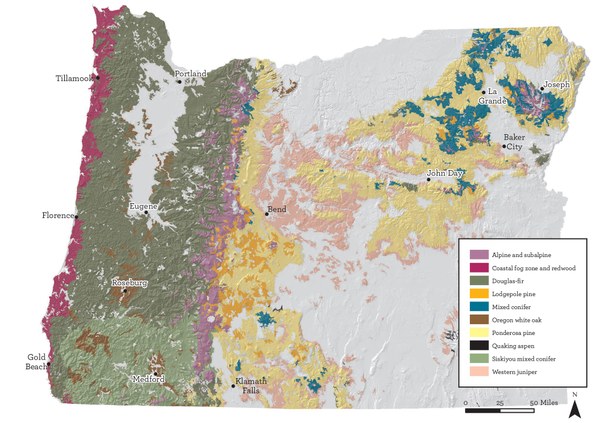 Map by Erik Fernandez, Oregon Wild. Click to enlarge.
Map by Erik Fernandez, Oregon Wild. Click to enlarge.
In this book we explore the major types of ancient forests in Oregon, which appear on the map. Riparian forests, found on the banks of rivers, lakes, and other natural waterways, are mixed in with all the other types and are not shown on the map. These forests are often dominated by deciduous trees like maple, alder, and cottonwood, as well as a variety of shrubs. They can be found in featured hikes in every region in this book.
ALPINE AND SUBALPINE
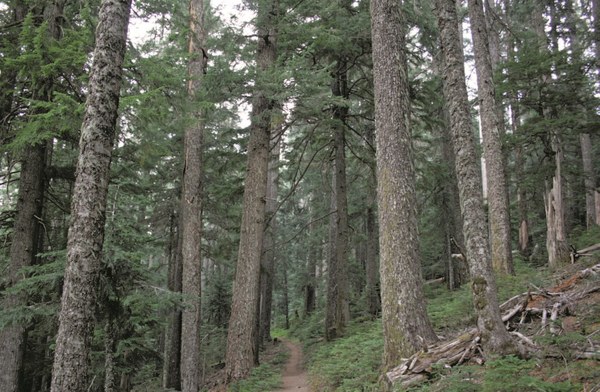 Subalpine forests of noble fir, silver fir, and hemlock are found near Barlow Pass along the PCT. Photo by Chandra LeGue.
Subalpine forests of noble fir, silver fir, and hemlock are found near Barlow Pass along the PCT. Photo by Chandra LeGue.
Generally found at elevations above 5000 feet, trees in alpine and subalpine forests are adapted to colder temperatures, a shorter growing season, and a lot of snow. Species typically not found elsewhere include Pacific silver fir, subalpine fir, noble fir, Alaska yellow-cedar, and mountain hemlock. The trees here don’t grow as large as those at lower elevations, though they include such species as western hemlock, Douglas-fir, western white pine, Shasta red fir, and Engelmann spruce, which also grow in more hospitable conditions. At the highest elevations, outcrops of stunted and less common trees like whitebark pine grow in scattered pockets. These forests tend to have a few hundred years between fires, allowing for a long recovery and natural development of diverse species. Featured hikes in this forest type can be found in the Mount Hood, Upper Willamette and McKenzie, Upper Umpqua, South Cascades, Northern Blue Mountains, and Wallowas regions.
COASTAL FOG ZONE AND REDWOOD
These forests thrive only within a dozen miles or so of the coastline, where high humidity, from fog and rain, and mild temperatures prevail. Most of this zone is dominated by Sitka spruce, with western hemlock, western redcedar, Douglas-fir, and red alder mixed in. The forest understory is usually lush with moss, shrubs, and ferns, and young trees commonly grow on nurse logs packed with moisture and nutrients. Right along the shoreline, shore pine (a variety of lodgepole pine) can grow in dense, short forests. On the far southern coast, this forest type includes coast redwoods and evergreen hardwoods like Oregon myrtle and tanoak. Fires are few and far between, as fuels don’t often dry out enough to be easily ignited. Featured hikes in this forest type can be found in the North Coast, Central Coast Range, and South Coast and Kalmiopsis regions.
DOUGLAS-FIR
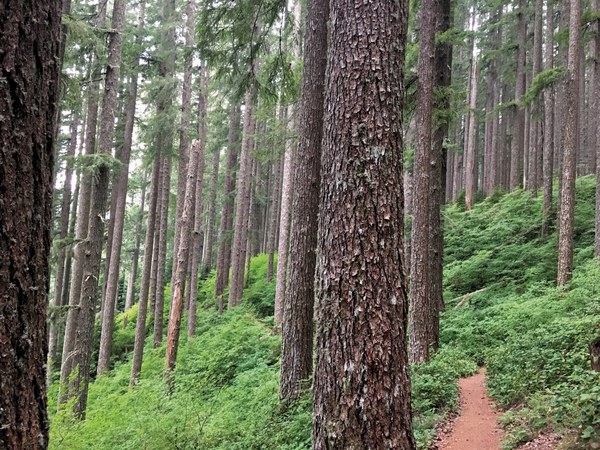 Douglas-firs and western hemlocks line the East Ridge Trail on Marys Peak. Photo by Chandra LeGue.
Douglas-firs and western hemlocks line the East Ridge Trail on Marys Peak. Photo by Chandra LeGue.
Douglas-fir forest covers more of Oregon than any other, primarily on the west side of the Cascades, though Douglas-fir trees are found in the mixed conifer forest types as well. These forests are dominated by their namesake tree, but in moister and riparian areas there are also western hemlock, western redcedar, Pacific yew, bigleaf maple, and alder; and on drier sites incense cedar, madrone, and chinquapin. Douglas-fir, western hemlock, and red cedar can grow to astounding sizes in these forests if left undisturbed, and hemlocks can take over as the dominant tree after five hundred years or so. These forests often have the best examples of classic ancient forest structure. Featured hikes in this forest type can be found in all regions west of the Cascade Crest.
LODGEPOLE PINE
These forests are often found in pure, dense stands originating after a fire or other disturbance. They grow quickly, and once they reach eighty to one hundred years they often experience disturbance from fire and/or insect outbreaks. If this doesn’t happen, they often get overtopped by shade-tolerant species like white fir, ponderosa pine, or Engelmann spruce, which can live much longer and develop into a more classic old-growth forest. Lodgepole pine forests grow in diverse climates but often grow on pumice or other dry soils, in cold microclimates, and in areas with dry summers and longer, cold winters. Featured hikes in this forest type can be found in the Central Oregon, Klamath-Lakeview, and Northern Blue Mountains regions.
MIXED CONIFER
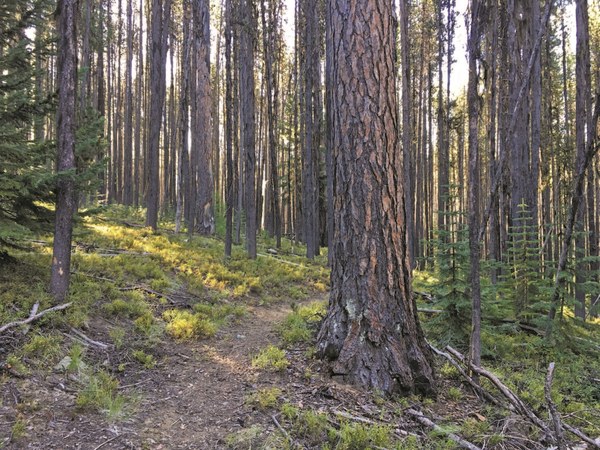 Lodgepole pines are mixed with giant larch trees along the South Fork Desolation Creek Trail. Photo by Chandra LeGue.
Lodgepole pines are mixed with giant larch trees along the South Fork Desolation Creek Trail. Photo by Chandra LeGue.
Mixed conifer forests are generally found east of the Cascades in areas that get more moisture than the ponderosa pine forest type. Mixed conifer forest covers a range of elevations, depending on the slope, aspect, and moisture levels of the area. Tree species are truly mixed, and include Douglas-fir, white fir, Shasta red fir, noble fir, western larch, Engelmann spruce, lodgepole pine, incense cedar, sugar and western white pine, Pacific yew, and ponderosa pine. Western larch trees dominate some mixed conifer areas at elevations between 3000 and 7000 feet and stand out in autumn when their deciduous needles turn brilliant yellow. In riparian areas, these forests can have a mix of large cottonwood, alder, and other hardwood species. These forests can be very long-lived, with dominant species components changing over time and through disturbances like fire. Featured hikes in this forest type can be found in the South Cascades, Klamath-Lakeview, Northern Blue Mountains, Blue Mountains, and Wallowas regions.
OREGON WHITE OAK
These forests are found throughout the southern portion of western Oregon, spread across the lowand middle-elevation hillsides of the Willamette, Umpqua, and Rogue River valleys. Open oak woodlands were once more common, but fire suppression and agricultural development have reduced their extent. White oak forests can be found in the featured hikes in the Mount Hood region.
PONDEROSA PINE
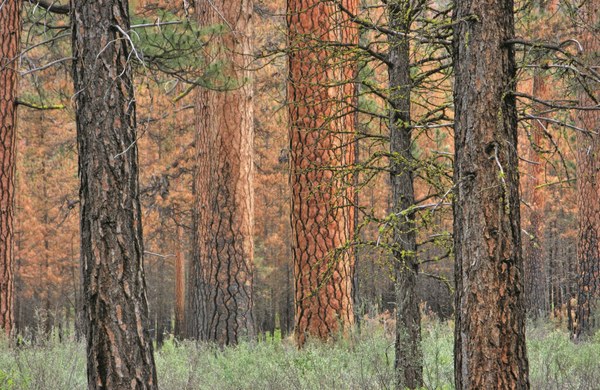 A forest of ponderosa pines lines the spectacular Wild and Scenic Metolius River. Photo by Brizz Meddings.
A forest of ponderosa pines lines the spectacular Wild and Scenic Metolius River. Photo by Brizz Meddings.
Found mostly on drier sites in central and eastern Oregon, these forests cover a vast area. Ponderosa pine dominates, but lodgepole pine, aspen, Douglas-fir, western larch, incense cedar, western white pine, and some other species can be found mixed in. The understory of these forests is often dominated by grasses, and riparian areas have aspen, cottonwood, willows, and other shrubs. Frequent, low-intensity fires historically played a big role in shaping this forest type, clearing out brush and young trees and keeping the forest in a savannah-like state in many areas. Featured hikes in this forest type can be found in the Central Oregon, Klamath-Lakeview, Blue Mountains, and Wallowas regions.
QUAKING ASPEN
This forest appears on the map, but aspens also grow mixed in with other forest types. Aspens can be found in featured hikes in the Mount Hood, South Cascades, Central Oregon, Klamath-Lakeview, Blue Mountains, and Wallowas regions.
SISKIYOU MIXED CONIFER
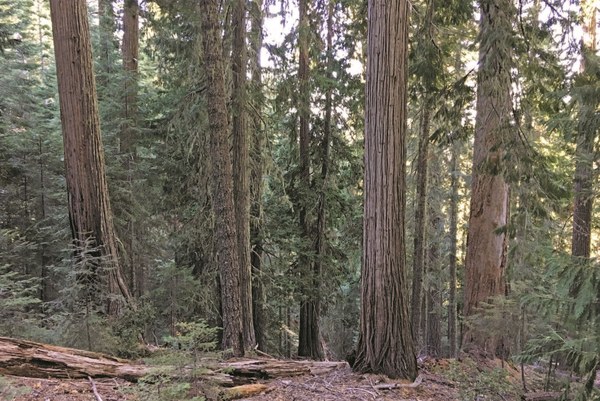 A diverse forest, including both Port Orford and incense cedars, is found on the Big Tree Trail in the Oregon Caves National Monument and Preserve. Photo by Chandra LeGue.
A diverse forest, including both Port Orford and incense cedars, is found on the Big Tree Trail in the Oregon Caves National Monument and Preserve. Photo by Chandra LeGue.
Siskiyou mixed conifer forests comprising hardwoods mixed with conifers are largely confined to southwest Oregon from the Rogue River valley south and inland to the Cascade Crest. They are characterized by diversity: in addition to Douglas-fir, sugar pine, ponderosa pine, incense cedar, various firs, and western white pine, there are also madrone, chinquapin, tanoak, and canyon live oak. Other rare tree species in this forest type in specific microclimates include Jeffrey pine (found on serpentine soils), Port Orford cedar, Oregon myrtle, and Brewer’s spruce. Fire historically played a role in maintaining the diversity, but the varied topography, soil types, and microclimates also contribute. Featured hikes in this forest type can be found in the Siskiyou Crest and South Coast and Kalmiopsis regions.
WESTERN JUNIPER
The driest forests in the state, western junipers blanket a big portion of central and eastern Oregon’s high desert region. Junipers tend to grow in hot, dry areas widely spaced from one another and surrounded by sagebrush and grasses. Junipers are also interspersed within other forest types on rocky outcroppings or in other dry microclimates. Frequent fires in this forest type once limited its distribution, but fire suppression has allowed it to expand over the past century. Featured hikes within the Siskiyou Crest, Mount Hood, Central Oregon, and Blue Mountains regions include this forest type.

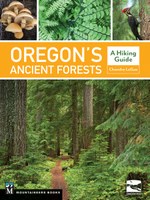 Explore these forests with Oregon’s Ancient Forests: A Hiking Guide, which expertly shows you the way through dripping coastal forests of giant Douglas-firs, high desert groves of massive ponderosa pines, lush mixed conifer forests surrounding jagged Cascade peaks, and more. You can also meet the author, Chandra LeGue of Oregon Wild, at events around Oregon.
Explore these forests with Oregon’s Ancient Forests: A Hiking Guide, which expertly shows you the way through dripping coastal forests of giant Douglas-firs, high desert groves of massive ponderosa pines, lush mixed conifer forests surrounding jagged Cascade peaks, and more. You can also meet the author, Chandra LeGue of Oregon Wild, at events around Oregon.
A portion of the proceeds from the sale of this book benefit Oregon Wild and their advocacy work to protect Oregon’s most precious wild areas.
 Chandra LeGue
Chandra LeGue
